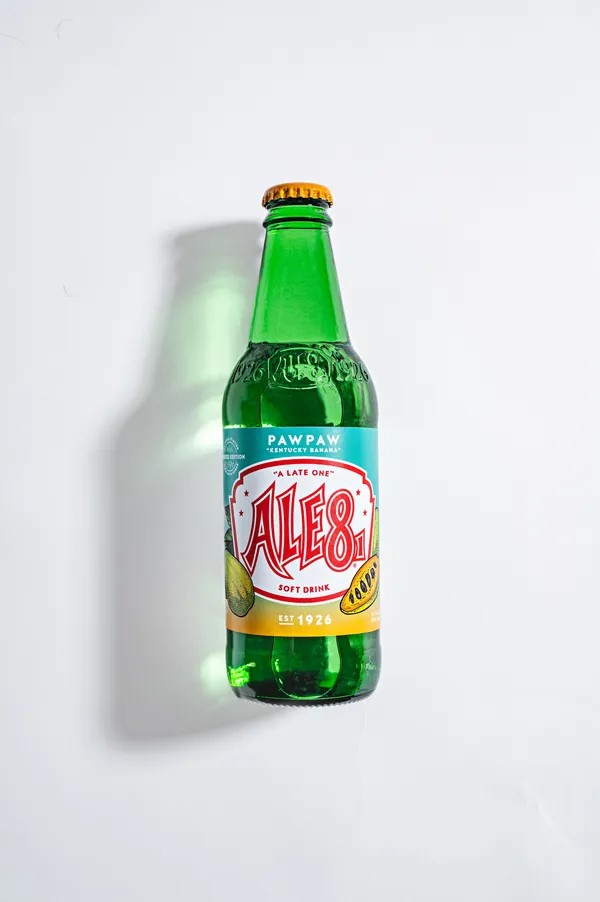By Kirby Adams, Louisville Courier Journal
 The Kentucky pawpaw is having a moment. The tropical fruit, which resembles a green
potato and tastes like a combo of mango, banana and pineapple, is making its way into
wine, pies, bourbon, jams, and now a soft drink.
The Kentucky pawpaw is having a moment. The tropical fruit, which resembles a green
potato and tastes like a combo of mango, banana and pineapple, is making its way into
wine, pies, bourbon, jams, and now a soft drink.
If this is the first you've heard of the pawpaw, and you've never tasted one, you're in luck.
The Kentucky State University pawpaw program and Ale-8-One, a favorite Kentucky-made soft drink, have partnered to create a uniquely Kentucky flavor in each bottle of Pawpaw Ale-8.
"Kentucky is the hotbed of pawpaw activity, no doubt about it," said Kirk Pomper with the KSU Horticulture Department.
A pawpaw is a native tree fruit found in the forest understory in Kentucky, often along streams and rivers. In 1990, Kentucky State University began a research program focused on developing pawpaw as a new tree-fruit crop for Kentucky. The program is the only full-time pawpaw research program in the world, working on propagation methods, orchard management, regional variety trials, fruit ripening and storage techniques, and more.
There are currently 93 pawpaw growing farms in Kentucky. Only Ohio has more pawpaw farms, with 150 growers currently producing the fruit.
It's the state's connection to the pawpaw that inspired the bubbly collaboration.
The Pawpaw Ale-8 will be available beginning Monday, Aug. 4, as a limited release four-pack at retailers across Kentucky. For up-to-date information on the launch in your area, follow Ale-8-One social media.
"Made with real sugar, natural flavors, and no dyes, the one-of-a-kind flavor of Pawpaw Ale-8 "is brimming with tropical flavors reminiscent of the exotic shores of the Bluegrass," according to a statement from Kentucky State University.
The limited edition Pawpaw Ale-8 joins other offerings from the Kentucky soft drink company located in Winchester, Kentucky, including Ale-8-One, Ale-8 Zero Sugar, Heritage, Caffeine Free and Zero Sugar, Orange Cream, Cherry, Cherry Zero Sugar, and seasonal flavors like Blackberry.
Before you run out and pick up a four-pack of this limited-edition soft drink, here are a few things to know about the native fruit, nicknamed the “Kentucky Banana.”
What is a pawpaw?
A pawpaw is a native tree fruit found in the forest understory in Kentucky, often along streams and rivers and is a new crop for Kentucky farmers. A few famous pawpaw fans included George Washington, Thomas Jefferson, Daniel Boone and explorers Lewis and Clark.
How do you eat a pawpaw?
Picked straight from the tree, you don't want to eat the green skin or the brown seeds of the pawpaw. But the sweet and creamy, custard-like orange-yellow pulp is delicious and can be used as an ingredient in gourmet items such as ice cream, wine, pies, jams and now, a soft drink.
Thanks to its flavor and texture, the "Kentucky Banana" is also used in baked goods and desserts such as Pawpaw Oat Bars , Pawpaw No Bake Cheesecake, Pawpaw cookies, Pawpaw Pudding and more.
Pawpaws are high in antioxidants and can be eaten the fruit fresh from the tree. The fruit is used as a substitute for bananas in recipes. You'll find more than a dozen recipes on the Kentucky State University website at kysu.edu.
Why can't I find a pawpaw at the grocery store?
With so many uses, why isn't the pawpaw more popular? According to Pomper, the pawpaw doesn't last long once it's been picked from the tree. Fully ripe pawpaws must be consumed quickly because they only last a few days at room temperature.
"We have been working on how to best grow, fertilize and breed the pawpaw," Pomper said. "But the biggest question is how to make it less perishable."
When do I pick a pawpaw?
Depending on the variety, the fruit ripens in late August to early October. According to the Kentucky State University Pawpaw program, color changes are not a good way to determine ripeness. Instead, gently squeeze the fruit and if it yields somewhat, similar to a ripe peach, it's ready. Ripe pawpaws should detach readily from the tree with a gentle tug and should have a strong, pleasant fruity aroma.